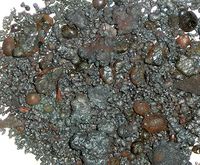Difference between revisions of "Boron"
| (One intermediate revision by the same user not shown) | |||
| Line 1: | Line 1: | ||
[[File:Boron - Wikimedia Commons.jpg|200px|thumb|right|Boron]] | [[File:Boron - Wikimedia Commons.jpg|200px|thumb|right|Boron]] | ||
Boron is the chemical element with atomic number 5 and the chemical symbol B. Boron is a metalloid. | Boron is the chemical element with atomic number 5 and the chemical symbol B. Boron is a metalloid. | ||
| − | |||
== Boron as nutrient for plants == | == Boron as nutrient for plants == | ||
| Line 13: | Line 12: | ||
== References == | == References == | ||
<references /> | <references /> | ||
| + | |||
| + | == External links == | ||
| + | * [http://en.wikipedia.org/wiki/Boron Boron] Wikipedia | ||
[[Category:Nutrients in food]] | [[Category:Nutrients in food]] | ||
[[Category:Minerals]] | [[Category:Minerals]] | ||
[[Category:Nutrients for plants]] | [[Category:Nutrients for plants]] | ||
Latest revision as of 18:05, 21 January 2012
Boron is the chemical element with atomic number 5 and the chemical symbol B. Boron is a metalloid.
Boron as nutrient for plants
Boron is an essential plant nutrient, required primarily for maintaining the integrity of cell walls.
Boron as nutrient in food
Boron occurs in various forms in fruits, vegetables and nuts. See this page for food sources of boron.
People take boron supplements as medicine. Boron is used for building strong bones, treating osteoarthritis, as an aid for building muscles and increasing testosterone levels, and for improving thinking skills and muscle coordination. Women sometimes use capsules containing boric acid, the most common form of boron, inside the vagina to treat yeast infections. People also apply boric acid to the skin as an astringent or to prevent infection; or use it as an eye wash.[1]
References
External links
- Boron Wikipedia

